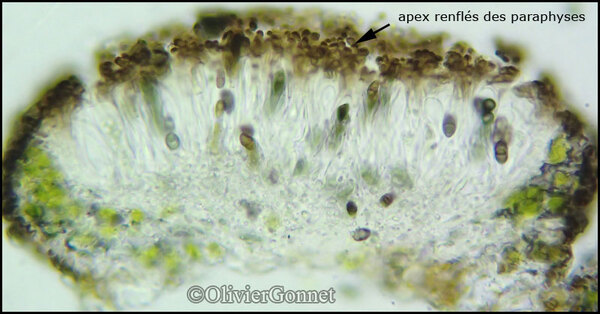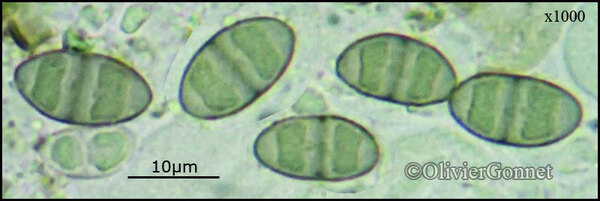Rinodina freyi H. Magn.
Acta Horti Gothob., 17: 236, 1947.
Synonyms: Rinodina glauca Ropin; Rinodina ramulicola Kernst. ex Arnold nom. illegit.; Rinodina septentrionalis auct. p.p. non Malme
Distribution: N - Ven (LD- 1171611), TAA (Nascimbene & al. 2007b, Sheard 2010, Nascimbene 2014), Lomb, Piem, VA (Matteucci & al. 2015d), Emil (Giralt & Mayrhofer 1995, Fariselli & al. 2020). C - Sar (Giralt & Mayrhofer 1995, Zedda 2002).
Description: Thallus crustose, episubstratic, rimose to areolate, sometimes evanescent, dark grey to grey-green or grey-brown, dull, without a distinct prothallus. Areoles flat, contiguous, to >0.2 mm wide. Apothecia lecanorine, crowded, broadly attached, 0.3-0.7 mm across, with a dark brown to black, persistently flat disc, and a thin, entire to flexuose, persistent thalline margin. Thalline exciple 50-70 µm wide laterally, corticate, more or less expanded below in a prosoplectenchymatous tissue; proper exciple 5-10 µm wide laterally, expanding to 15-30 µm at periphery; epithecium pale red-brown; hymenium colourless, 60-80 µm high; paraphyses coherent, 2-3 µm thick at mid-level, the apical cells 4-5 µm wide, immersed in a dispersed pigment; hypothecium colourless. Asci 8-spored, clavate, the K/I+ blue tholus penetrated by a faintly amyloid apical cushion with parallel or diverging flanks, the wall K/I-, surrounded by a K/I+ blue outer layer, Lecanora-type. Ascospores 1-septate, brown, ellipsoid, (11.5-)14-15.5(-18) x (5.5-)7-8(-9.5) µm, Physcia-type, thick-walled at apices, with a prominent torus, the ontogeny of type A (apical wall thickening after septum formation). Photobiont chlorococcoid. Spot tests: K-, C-, KC-, P-, UV-. Chemistry: without lichen substances. Note: a subarctic-subalpine to boreal-montane, probably circumpolar lichen found on shrubs and on moribund plants. The species was treated together with R. glauca as a synonym of R. septentrionalis by Giralt & Mayrhofer (1995). Sheard (2010) distinguishes R. freyi and R. septentrionalis, placing R. glauca as a synonym of R. freyi. R. septentrionalis is a nordic species, and its records from the central and southern European mountains, including Italy (see Nimis 2016) refer to R. freyi. The very dubious records of R. septentrionalis by Grillo (1996) from Sicily and Frati & Brunialti (2006) from the Marche are not accepted here.
Growth form: Crustose
Substrata: bark
Photobiont: green algae other than Trentepohlia
Reproductive strategy: mainly sexual
Pioneer species
Commonnes-rarity: (info)
Alpine belt: absent
Subalpine belt: very rare
Oromediterranean belt: absent
Montane belt: very rare
Submediterranean belt: absent
Padanian area: absent
Humid submediterranean belt: absent
Humid mediterranean belt: absent
Dry mediterranean belt: absent
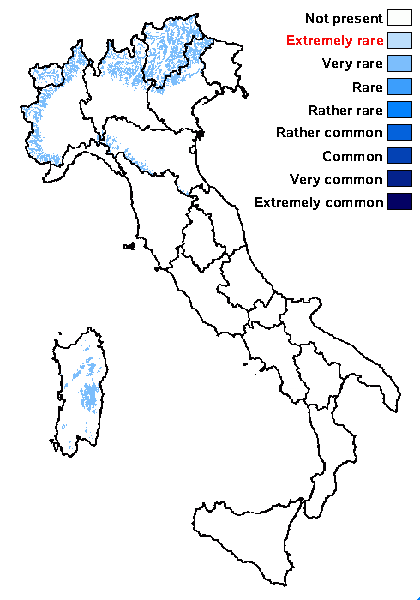
Predictive model
Herbarium samples
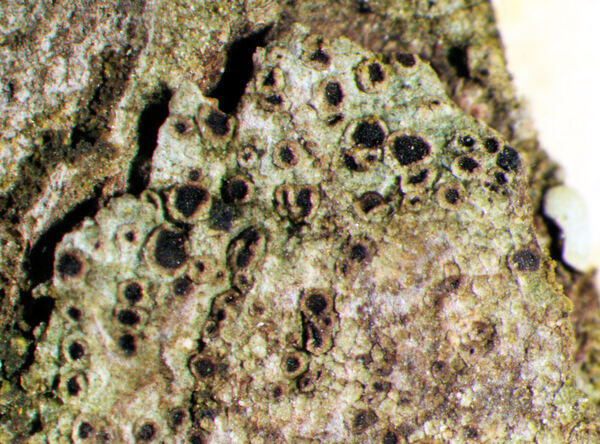
Harrie Sipman – Source http://www.bgbm.fu-berlin.de/sipman/Zschackia/AegeanLichens/CaloplacaAC.htm - As Caloplaca oasis
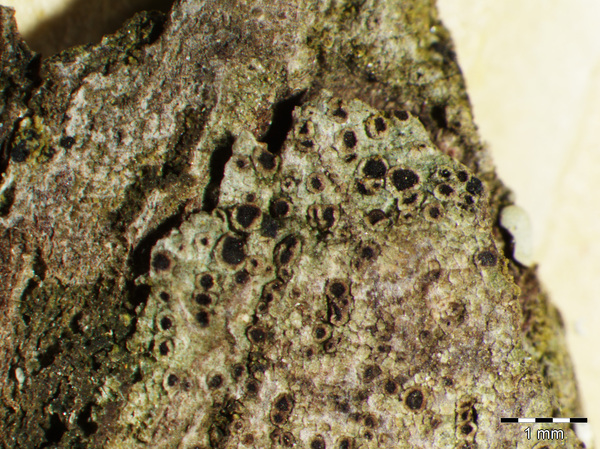
Harrie Sipman – Source http://www.bgbm.fu-berlin.de/sipman/Zschackia/AegeanLichens/CaloplacaAC.htm - As Caloplaca oasis
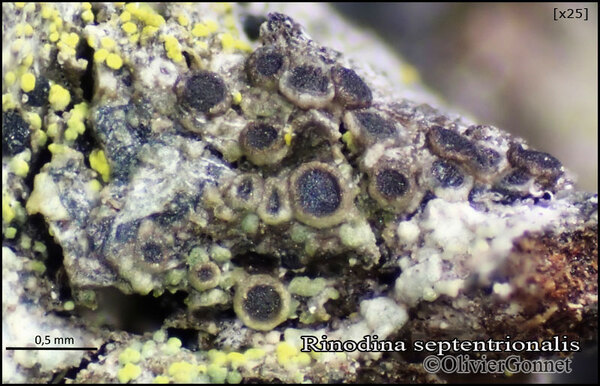
Courtesy Danièle et Olivier Gonnet - Source: https://www.afl-lichenologie.fr/Photos_AFL/Photos_AFL_R/Textes_R/Rinodina_septentrionalis.htm
France, 7/6/2016 - sur Juniperus communis - Névache - Hautes-Alpes
as R. septentrionalis
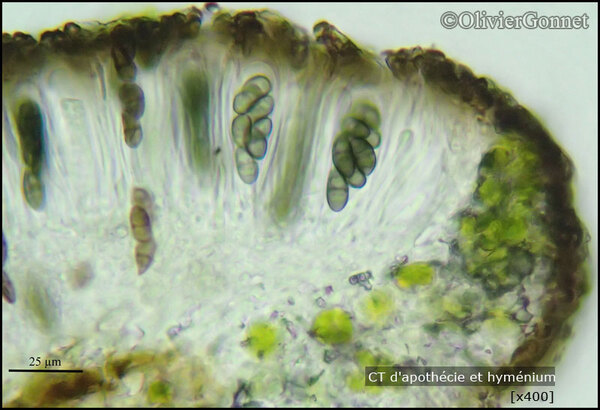
Courtesy Danièle et Olivier Gonnet - Source: https://www.afl-lichenologie.fr/Photos_AFL/Photos_AFL_R/Textes_R/Rinodina_septentrionalis.htm
France, 7/6/2016 - sur Juniperus communis - Névache - Hautes-Alpes
as R. septentrionalis
Growth form: Crustose
Substrata: bark
Photobiont: green algae other than Trentepohlia
Reproductive strategy: mainly sexual
Pioneer species
Commonnes-rarity: (info)
Alpine belt: absent
Subalpine belt: very rare
Oromediterranean belt: absent
Montane belt: very rare
Submediterranean belt: absent
Padanian area: absent
Humid submediterranean belt: absent
Humid mediterranean belt: absent
Dry mediterranean belt: absent

Predictive model
| Herbarium samples |

Harrie Sipman – Source http://www.bgbm.fu-berlin.de/sipman/Zschackia/AegeanLichens/CaloplacaAC.htm - As Caloplaca oasis

Harrie Sipman – Source http://www.bgbm.fu-berlin.de/sipman/Zschackia/AegeanLichens/CaloplacaAC.htm - As Caloplaca oasis

Courtesy Danièle et Olivier Gonnet - Source: https://www.afl-lichenologie.fr/Photos_AFL/Photos_AFL_R/Textes_R/Rinodina_septentrionalis.htm
France, 7/6/2016 - sur Juniperus communis - Névache - Hautes-Alpes
as R. septentrionalis

 Index Fungorum
Index Fungorum
 GBIF
GBIF
